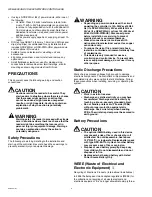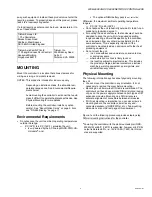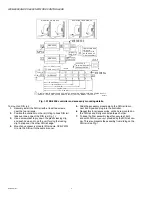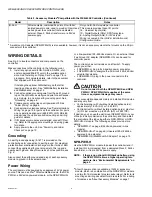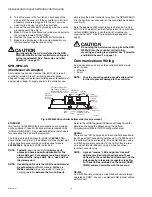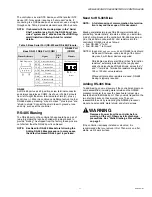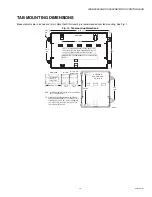
WEB-600E AND CP-600E NETWORK CONTROLLERS
62-0433—01
10
3.
To do this, press in the four tabs on both ends of the
unit, and lift the cover off. If the controller or a IO-16-H
accessory module is plugged into the unit, you may
need to slide it away to get to the cover tabs.
4.
Connect the supplied earth grounding wire to a nearby
grounding point. See Fig. 5.
5.
Make AC circuit connections line (mains) and neutral to
the terminals labeled “INPUT PWR.”
6.
Replace the cover on the NPB-PWR-UN-H module.
7.
Make sure all modules in the mounted assembly are
firmly connected together and secured.
CAUTION
Do not energize the AC circuit wired to the NPB-
PWR-UN-H until all other controller mounting and
wiring is completed. See “Power Up and Initial
NPB-WPM-US
(Wall Mount AC Adapter)
All models of wall power modules (US, EUR, UK) are self-
contained, isolated, Class 2, switching power supplies
designed to plug into a standard building power receptacle of
appropriate voltage. To supply power to the controller, you
simply plug the barrel connector plug from the NPB-WPM-US
into the barrel power connector on the controller’s base board
Note the adapter’s 15W output rating is derated 50% at the
60°C (140°F) maximum ambient temperature (for a controller
without
a NiMH battery), such that
no I/O modules are
supported at 60°C
. See “Environmental Requirements” on
CAUTION
Do not plug the barrel connect plug from the NPB-
WPM-US into the controller until all other
mounting and wiring is completed. See “Power Up
and Initial Checkout” on page 13.
Communications Wiring
Communications ports are on the controller’s bottom side,
which include:
• Ethernet
• Serial
NOTE: Prior to connecting cables, provide strain relief
for them to prevent damage to the controller.
Fig. 6. WEB-600E controller bottom side (cover removed).
ETHERNET
Two, female 10/100-Mbit Ethernet connections are provided
on the controller. These RJ-45 connectors are labeled LAN1
(PRI) and LAN2 (SEC). Use a standard Ethernet patch cable
for connecting to a hub or Ethernet switch.
The factory-default IP address for LAN1 is
192.168.1.12
n
,
where the last numeral
n
in the address matches the last digit
in the controller’s serial number, and the subnet mask is
255.255.255.0
.
By default, LAN2 is disabled.
NOTE: Typically, you
only use LAN1
(primary port),
unless you have a specific application for the
other LAN2 port. For example, isolating a driver’s
network traffic, using LAN2. Do
not
use LAN2 as
the primary port.
NOTE: If enabling LAN2, note that LAN1 and LAN2 must
be connected to
different subnets
. Further, a
WEBs controller
does not provide IP routing or
bridging operation
between the two LAN ports.
Refer to the
JACE NiagaraAX Install and Startup Guide
for
details on changing IP address using the platform
Commissioning Wizard (TCP/IP configuration step).
SERIAL
There are two “RS” serial ports on the controller’s base board.
Each has a UART capable of operation up to 115,200 baud. At
the bottom of the board (see Fig. 6) is an RS-232 port using
an DB-9 plug (male) connector. To the right of this is a two-
wire plus shield RS-485 port, using a 3-position screw-
terminal connector plug.
NOTE: A green “receive” LED and yellow “transmit”
LED are provided for both serial ports. These
LEDs are on the controller’s bottom board, on the
side opposite to the serial connectors (see Fig.
3). These LEDs are labeled on the board (COM1,
COM2) and are not visible with the cover on.
RS-232
An RS-232 serial port using a male DB-9 connector always
operates as COM1. You can use standard DB-9 serial cables
with this port.
M33920
EARTH
GROUND
SPADE LUG
PRIMARY
ETHERNET
(RJ-45) LAN 1
SECONDARY
ETHERNET
(RJ-45) LAN 2
OPTIONAL NIMH BATTERY
AND BRACKET ASSEMBLY, IF
INSTALLED, MOUNTS ON TOP
OF THE OPTION SLOT AREA.
RS-485
(3-POS.)
COM2
RS-232
(DB-9)
COM1
BARREL POWER
CONNECTOR FOR
NPB-WPM-US (WALL
MOUNT AC)
20-PIN
CONNECTOR
(I/O AND
POWER
MODULES)
OPTION
SLOT AREA
(SLOT #1
THIS SIDE)


